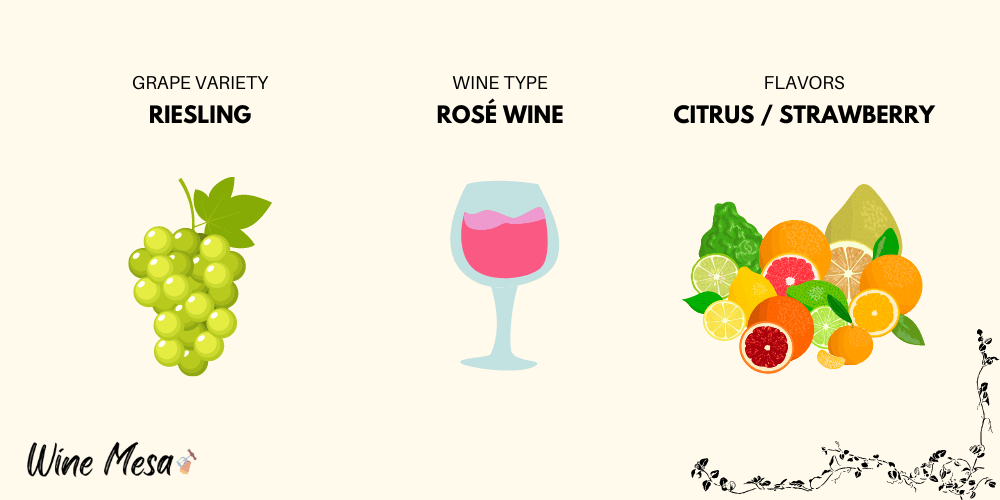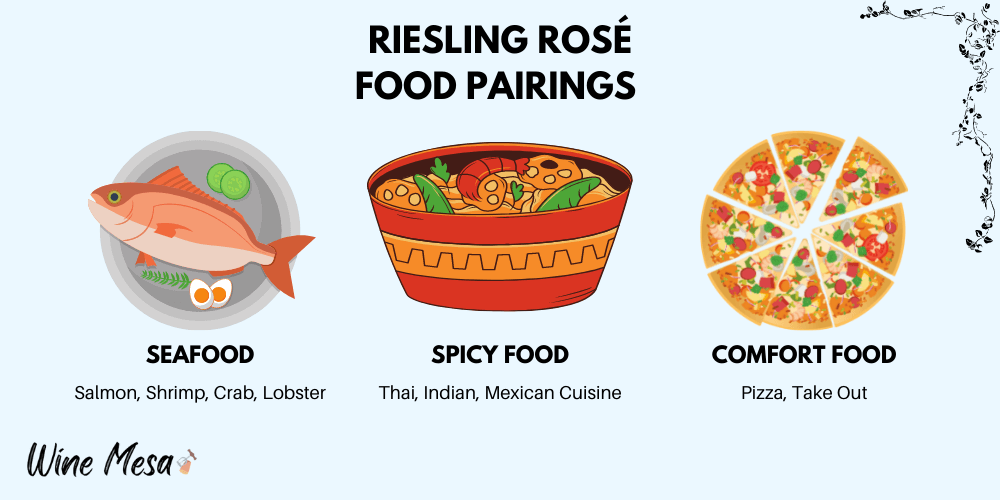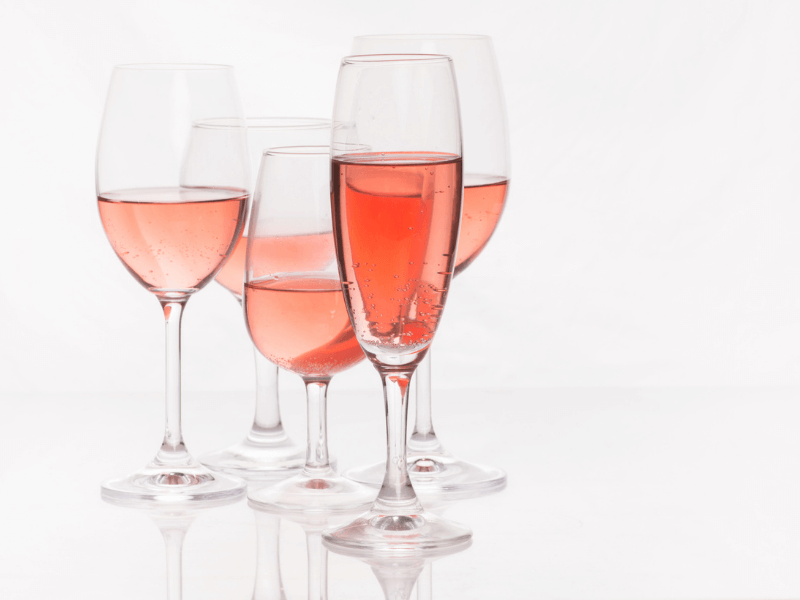Riesling Rosé is a type of pink-colored wine made from Riesling grapes. Riesling Rosés are often considered the most fruity rosés available, and they tend to have a pronounced fruit flavor with noticeable acidity.

What Does Riesling Rosé taste Like?
Riesling Rosé tastes like a lighter version of white wine, often described as “not too sweet” and “fresh.” It generally has a citrus, strawberry, cherry, and pear flavor, depending on the grape variety used to make the wine.
It also often has a slightly effervescent quality that makes it seem lighter than typical wines. The wine can have a crisp quality that makes it refreshing to drink.
Best Riesling Rosé Examples
Deep Roots Pink Riesling – This wine is true to the Riesling name, with citrus and green apple aromas. It makes for a fruity wine with low tannins and acidity. Additional flavors include melon, peach, Meyer lemon, lime zest, mineral water, jasmine flowers, rose petals, Mediterranean herbs, and white pepper. It’s a very easy drinking wine but has the full flavor of Riesling.
Paddle Creek Riesling Rosé – This wine is dry and crisp, with apple flavors accented by green notes of grapefruit. It finishes cleanly with kumquat flavors, rosewater, and sweet citrus fruits. This wine is one you can enjoy year-round.
Silver Lake Roza Riesling Rosé – This wine has the aromas of juicy red apples combined with bright raspberry notes for a fresh fruit scent on the nose. You’ll taste cranberry and hibiscus flavors followed by juicy peach and pear for an approachable balance between sweet fruitiness and tangy acidity. Aromas lead to sweet lemon and sour cherry on the finish.
Candy Babee Pink Riesling – This wine is just like biting into a fresh, sweet grapefruit – it’s full of tart citrus flavors and severe acidity. It also has hints of green apple and fresh-picked strawberries on the nose. The taste profile is similar, with lots of fruit upfront before tangy acidity. This wine would pair nicely with spicy foods or Mexican cuisine.
Avery Lane Pink Riesling – Ripe strawberry notes follow the light aromas of peaches. The flavor presents itself as refreshingly balanced between sugary sweetness and bright acidity, making for an easy-to-drink wine that doesn’t overpower you with sugar or astringency. On the finish, there are flavors of peach, nectarine, watermelon rind, and honeydew melon.
What Food Pairs with Riesling Rosé?

Seafood – Seafood freshness pair well with crisp, light, and refreshing wines.
Most wine drinkers consider white wines the best wine pairing for seafood, but Riesling Rosé is an excellent option if you want to shake things up. Its sweetness brings out the umami flavors in many types of fish and shellfish, such as lobster or crab.
Spicy Foods – Riesling Rosé is a good complement for spicy foods because it does not have sugars that might intensify the spiciness but instead has tart acidity to cut through the spice.
It also has the aromas of citrus fruits, which are common ingredients in many spicy recipes.
Mexican Food is often very tangy and acidic due to lime or citrus juices as flavor agents. Riesling Rosé’s luscious acidity makes it an excellent drink pairing with tacos or burritos – or even just chips and salsa!
Pizza – Even though many people drink red wine with pizza, Riesling Rosé might be a better pairing.
The sweetness of the wine will balance out the acidity in tomato sauce, which can make any wine taste sour. It also tastes excellent alongside spicy Italian sausage or pepperoni.
Is Riesling Rosé Sweet or Dry?
Riesling rosé tends to be sweeter because of its fruit-forward flavor profile. However, it can also be made dry depending on which grapes are used during fermentation and how much residual sugar was added after fermentation was complete.
The varieties that tend to produce more sweet wines include Gewürztraminer, Pinot Gris, Pinot Noir, and white Zinfandel grape juices. Varieties that tend to produce more dry wines include Chardonnay and Merlot.
How is Riesling Rosé Made?
Saignée Method – also called the “bleeding method.”
Once you harvest your grapes, sort them according to variety and quality rather than color. This means that not every grape will necessarily need to be destined for rosé wine.
Crush your red or black grapes into a container designated for white wine production (you don’t want the juice from the red grapes to stain anything).
Pour off some of the unfermented juice into another tank or jug, leaving behind just enough juice in the winemaking vessel so that fermentation can still take place quickly and efficiently.
The amount of juice removed will depend on how much pink you want in your finished product, but it can be anywhere from 10-20%.
Allow this juice to ferment, and then repeat the process until you’ve added all of your crushed red or black grapes and achieve the desired color.
Blending Method
If fermenting red wine, harvest your grapes at their optimum ripeness (color). If fermenting white wine, let them stay on the vine just a little longer to maximize color and sugar content.
Harvest early enough, so they are not overripe but late enough that they have had time to develop flavor/aroma compounds.
Sort through your grapes for any rotten ones or leaves before crushing them. The ratio of grape varieties matters in terms of how strong different aromas will come through in the final product.
White wine grapes tend to have lower acidity and less sugar, making a more delicate rosé with fruitier flavors. Red wine grapes tend to be higher in acidity or sugar, meaning their juice will ferment faster and create a deeply colored rosé with berry undertones.
Crush your red wine grapes into a container designated for white wine production (you don’t want the juice from the red grapes to stain anything).
Pour off some of the unfermented juice into another tank or jug, leaving behind just enough juice in the winemaking vessel so that fermentation can still take place quickly and efficiently.
The amount of juice removed will depend on how much pink you want in your finished product, but it can be anywhere from 10-20%.
Harvest your white wine grapes at their optimum ripeness (color). Allow this juice to ferment, and then repeat the process until you’ve added all of your crushed red or black grapes.
